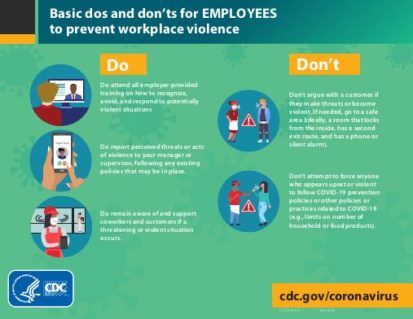Seyfarth Synopsis: The CDC published guidance aimed at assisting retail and service companies in limiting workplace violence against or involving their employees that may be associated with enforcing face mask mandates and other COVID-19 precautions.
On March 30, 2020, the United States Centers for Disease Control and Prevention (CDC) modified its guidance to recommend that all Americans who are able wear face masks in public places should do so to reduce the likelihood of disease transmission. Shortly thereafter, federal OSHA issued its COVID-19 Guidance for Retail Workers, in which the agency recommends that retailers "allow workers to wear masks over their nose and mouth to prevent them from spreading the virus." Since that time, the majority of state and local jurisdictions have recommended or mandated face masks for individuals in retail stores, including both employee and customers. Many state agencies have begun patrolling retailers and threatening enforcement based on customers and employees observed flouting face mask and social distancing requirements.
Masks are not the only COVID-19 protections that state and local jurisdictions have mandated or recommended in retail settings. Other protections include: required social distancing, cleaning and disinfecting protocols, capacity requirements, and others. All of these are aimed at allowing retailers to remain operational while attempting to protect both employees and customers from infection.
Retailer policies mandating the use of face masks and other requirements set forth by state and local jurisdictions, and attempts to enforce those policies, have resulted in workplace violence incidents against retail employees. According to media reports, customers refusing to wear masks have wiped their nose on an employee's clothing, coughed or sneezed on employees or other customers, broken an employee's arm, and fatally shot an employee, among other incidents. See, e.g., https://abcnews.go.com/US/incomprehensible-confrontations-masks-erupt-amid-covid-19-crisis/story?id=70494577; https://www.cnn.com/videos/us/2020/05/12/target-store-mask-fight-orig-mg.cnn; https://www.nytimes.com/2020/05/08/us/coronavirus-masks-dollar-store-shooting-flint-Michigan.html.
Under the Occupational Safety and Health Act's General Duty Clause, employers have a duty to "furnish to each of his employees employment and a place of employment which are free from recognized hazards that are causing or are likely to cause death or serious physical harm to his employees." 29 U.S.C. § 654(a)(1). State-plan OSH agencies have similar provisions in their state-specific OSH Act. Type II workplace violence, directed at employees by a customer or client, is a recognized hazard in the retail industry. See https://www.osha.gov/workplace-violence. Further, the Occupational Safety and Health Administration enforces employers' duty to protect employees against workplace violence, through citations and litigation before the Occupational Safety and Health Review Commission.
The CDC issued non-mandatory guidance with strategies to limit violence towards workers that may occur when businesses put in place policies and practices to help minimize the spread of COVID-19 among employees and customers. Specifically the CDC references its Interim Guidance for Businesses and Employers Responding to Coronavirus Disease 2019 (COVID-19) for general business guidance on preventing COVID-19.
The guidance offers Resources and Trainings on Workplace Violence, including:
- FAA Workplace Violence Prevention and Response
- FBI Workplace Violence: Issues in Response
- NIOSH Occupational Violence
- OSHA Recommendations for Workplace Violence Prevention Programs in Late-Night Retail Establishments
The guidance also recommends employee training for warning signs and response. It suggests that "employee training on workplace violence [] cover[] definitions and types of violence, risk factors and warning signs for violence, prevention strategies, and ways to respond to threatening, potentially violent, or violent situations." The guidance specifically recommends de-escalation training for employees.
The guidance also provides several illustrations, with one related to action that can be taken to prevent workplace violence, and the other regarding basic dos and don'ts for employees to prevent workplace violence:

Image from CDC
This guidance is non-mandatory, but may be helpful for employers addressing the issue of face-mask mandates, other COVID-19 prevention measures, and aggressive enforcement positions from state agencies.
Originally published by Seyfarth Shaw, August 2020
The content of this article is intended to provide a general guide to the subject matter. Specialist advice should be sought about your specific circumstances.





